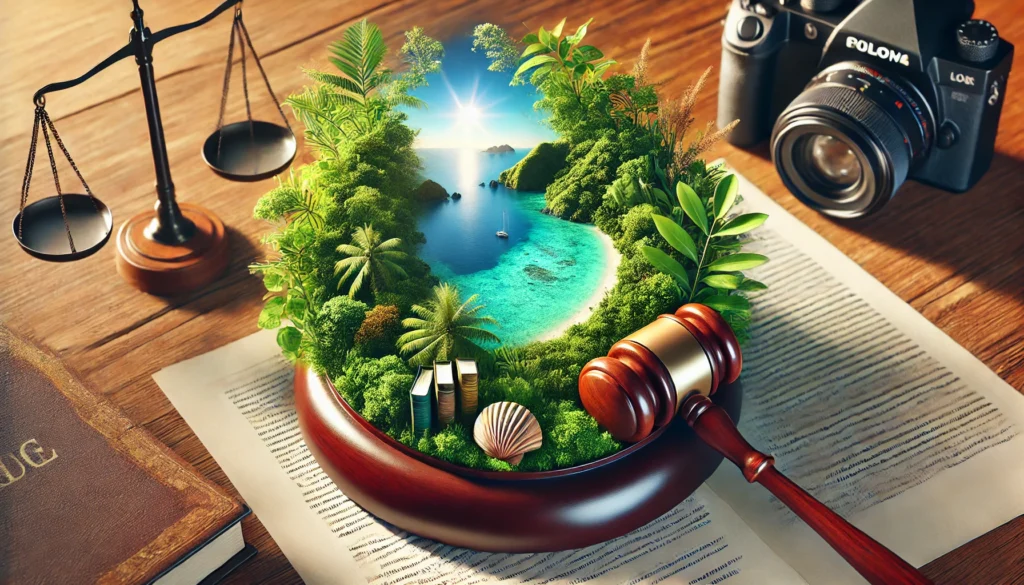Hey there, nature lovers and law enthusiasts! Buckle up, because we’re about to embark on a wild ride through the jungle of Philippine environmental laws. It’s a journey filled with twists, turns, and the occasional face-palm moment. But don’t worry, we’ll make it fun – promise!
The Green Revolution: How the Philippines Got Its Eco-Groove On
Picture this: it’s the 1970s. Disco is king, bell-bottoms are all the rage, and the Philippines is starting to realize that maybe, just maybe, we should stop treating Mother Nature like a giant trash can. Cue the dramatic music, folks, because this is where our environmental law saga begins!
The Birth of Environmental Awareness
Back in the day, the concept of environmental protection in the Philippines was about as common as a snowstorm in Manila. But then, like a bolt of green lightning, awareness struck! Suddenly, people were looking around and thinking, “Hey, maybe we shouldn’t be dumping all our stuff in the rivers. And those trees? Turns out they’re pretty important!”
This newfound enlightenment led to a flurry of activity in the legal world. Lawmakers, previously content with their usual politicking, found themselves thrust into the role of eco-warriors. Imagine a bunch of suit-wearing superheroes, armed with pens instead of swords, ready to save the planet – one legislation at a time!
The Environmental Code of 1977: The OG of Green Laws
In 1977, the Philippines decided to get serious about this whole “protecting the environment” thing. Enter Presidential Decree No. 1151, also known as the Philippine Environmental Policy. This bad boy was quickly followed by Presidential Decree No. 1152, the Philippine Environment Code. Together, they formed the dynamic duo of early environmental legislation.
These laws were like the first awkward steps of a baby giraffe – a bit wobbly, but hey, at least we were moving in the right direction! They laid out basic principles for environmental management and conservation. It was like the country collectively decided, “Okay, let’s try not to mess up this planet thing too much.”
From Baby Steps to Giant Leaps: The Evolution of Philippine Environmental Laws
As the years rolled by, our environmental laws grew up faster than a bamboo shoot on steroids. We went from “maybe we shouldn’t pollute so much” to “let’s create an entire ecosystem of laws to protect our natural resources.” Talk about a glow-up!
The 1987 Constitution: Getting Environmental Rights in Writing
When the 1987 Constitution came along, it was like the environment finally got its own VIP pass to the legal party. Article II, Section 16 declared that the State shall “protect and advance the right of the people to a balanced and healthful ecology.” In simpler terms, it’s like the country saying, “Hey, clean air and water? Yeah, that’s not just a nice-to-have, it’s a must-have!”
This constitutional provision became the backbone of environmental protection in the Philippines. It’s like the Captain Planet of our legal system – by its power combined, all other environmental laws draw strength!
The ’90s: When Environmental Laws Became Cool
The 1990s weren’t just about boy bands and dial-up internet. It was also the decade when the Philippines really started flexing its environmental law muscles. Let’s take a look at some of the greatest hits from this era:
- Republic Act No. 6969 (1990): The Toxic Substances and Hazardous and Nuclear Wastes Control Act. Because nothing says “party” like properly managed toxic waste, right?
- Republic Act No. 7586 (1992): The National Integrated Protected Areas System Act. This one’s for all you nature reserve enthusiasts out there!
- Republic Act No. 7942 (1995): The Philippine Mining Act. Because sometimes you need to dig a little deeper to protect what’s on the surface.
- Republic Act No. 8371 (1997): The Indigenous Peoples Rights Act. Protecting not just the land, but the people who’ve been its guardians for generations.
- Republic Act No. 8749 (1999): The Clean Air Act. Because breathing shouldn’t be an extreme sport.
It was like the lawmakers were on an eco-friendly caffeine high, churning out environmental laws faster than you can say “biodegradable”!
The New Millennium: Environmental Laws 2.0
As we entered the 2000s, the Philippines didn’t slow down its green law-making machine. If anything, we kicked it into overdrive! Let’s dive into some of the star players of this era.
Clean Water Act of 2004: Making a Splash in Environmental Protection
In 2004, the Clean Water Act (Republic Act No. 9275) came swooping in like a majestic Philippine eagle. Its mission? To save our water bodies from turning into giant soup bowls of pollution. This law was all about comprehensive water management, aiming to protect our rivers, lakes, and coastal areas from the onslaught of waste and contamination.
The Clean Water Act wasn’t just about saying “no” to pollution. It was about saying “yes” to sustainable water usage, “hello” to proper sewage treatment, and “what’s up” to water quality management. It’s like the law decided to be the responsible adult at the water park, making sure everyone plays nice and doesn’t pee in the pool.
Renewable Energy Act of 2008: Powering Up the Green Way
As if riding on a wave of eco-friendly energy itself, 2008 brought us the Renewable Energy Act (Republic Act No. 9513). This law was like the cool kid in school who convinced everyone that renewable energy was the way to go.
Solar panels, wind turbines, geothermal plants – this act gave them all a big thumbs up. It was as if the Philippines looked at fossil fuels and said, “It’s not you, it’s me. I think we should see other energy sources.” The law provided incentives for developing and utilizing renewable energy resources, making green energy not just environmentally friendly, but economically attractive too.
Climate Change Act of 2009: Taking on the Big Bad Wolf of Global Warming
In 2009, the Philippines decided to join the global fight against climate change with the Climate Change Act (Republic Act No. 9729). This law was our country’s way of saying, “Hey, climate change, we see you, and we’re not impressed!”
The act created the Climate Change Commission, which sounds like it could be a superhero team, doesn’t it? Led by none other than the President as the chairperson, this commission was tasked with coordinating, monitoring, and evaluating government programs related to climate change. It’s like we assembled our own Avengers to take on the Thanos of environmental issues!
The Nitty-Gritty: How These Laws Work in Real Life
Now, you might be thinking, “Wow, that’s a lot of laws! But do they actually do anything?” Well, my curious friend, let’s break it down and see how these laws translate into action on the ground.
Enforcement: The Tricky Part
Having laws is one thing; enforcing them is another kettle of fish entirely. It’s like having a really fancy gym membership – it looks great on paper, but it doesn’t do much if you don’t actually use it.
In the Philippines, various agencies are responsible for enforcing environmental laws. The Department of Environment and Natural Resources (DENR) is the main player here, but they’re not alone in this green crusade. They’re joined by other agencies like the Department of Agriculture, the Department of Energy, and local government units.
These agencies work together like a somewhat dysfunctional but well-meaning family, each with their own role in protecting our natural resources. It’s not always smooth sailing – sometimes it’s more like rowing a boat with mismatched oars – but they’re doing their best to keep our environment safe.
Challenges: It’s Not Easy Being Green
Let’s face it – implementing environmental laws in the Philippines is about as easy as trying to herd cats. We’ve got a few hurdles to overcome:
- Limited resources: Imagine trying to protect all the islands of the Philippines with a budget that’s smaller than a teleserye star’s wardrobe allowance. That’s the kind of challenge our environmental agencies face.
- Conflicting interests: Sometimes, economic development and environmental protection butt heads like two stubborn carabaos. Finding a balance is trickier than walking a tightrope while juggling flaming torches.
- Lack of awareness: Despite all these laws, some folks still think littering is a national pastime. Changing mindsets is like trying to teach your lola how to use a smartphone – it takes time and a lot of patience.
- Corruption: Unfortunately, not everyone plays by the rules. Some people view environmental regulations as mere suggestions, kind of like traffic lights in Manila during rush hour.
Success Stories: When Environmental Laws Save the Day
But it’s not all doom and gloom! Our environmental laws have had their fair share of wins. Let’s look at some success stories that’ll make you want to hug a tree (but please don’t, they need their personal space too).
Boracay Rehabilitation: From Paradise Lost to Paradise Regained
Remember when Boracay, our crown jewel of tourism, was closed for rehabilitation in 2018? It was like the whole country collectively gasped and said, “What do you mean we can’t party on the white sand beaches?”
But here’s the thing – it worked! Thanks to the enforcement of environmental laws, particularly the Clean Water Act and solid waste management regulations, Boracay went from being called a “cesspool” by the President to regaining its status as a world-class beach destination. It’s like the island went to environmental rehab and came back glowing!
Table: Boracay Before and After Rehabilitation
| Aspect | Before Rehabilitation | After Rehabilitation |
|---|---|---|
| Water Quality | High coliform levels | Significantly improved |
| Waste Management | Inadequate | Improved systems in place |
| Number of Tourists | Overcrowded | Controlled entry |
| Environmental Compliance | Low | Strictly enforced |
Protected Areas: Nature’s VIP Lounges
Thanks to the National Integrated Protected Areas System Act, the Philippines has designated numerous areas as protected. These are like exclusive clubs for flora and fauna, where human activity is limited and nature gets to do its thing.
As of 2020, we had 244 protected areas covering over 7.8 million hectares. That’s larger than the entire land area of Ireland! It includes famous spots like the Puerto Princesa Subterranean River National Park and the Tubbataha Reefs Natural Park. These areas are living proof that when we give nature a chance, it can thrive.
Table: Protected Areas in the Philippines (as of 2020)
| Category | Number | Total Area (hectares) |
|---|---|---|
| National Parks | 65 | 1,484,357 |
| Protected Landscapes/Seascapes | 35 | 1,387,006 |
| Natural Monuments | 8 | 30,664 |
| Resource Reserves | 3 | 1,972 |
| Others | 133 | 4,896,001 |
| Total | 244 | 7,800,000 |
The Road Ahead: Future of Philippine Environmental Laws
As we look to the future, it’s clear that our journey in environmental protection is far from over. It’s more like we’ve just finished the warm-up and are now ready for the main event!
Emerging Challenges: New Threats on the Horizon
The environmental landscape is constantly changing, and new challenges are popping up faster than you can say “biodegradable plastic.” Here are some issues we need to keep an eye on:
- Plastic pollution: Our oceans are turning into giant plastic soups. We need stricter regulations on single-use plastics and better waste management systems.
- Deforestation: Despite our efforts, our forests are still shrinking faster than a cotton shirt in hot water. We need to beef up our reforestation programs and crackdown on illegal logging.
- Urban air pollution: Our cities are starting to look like they’re perpetually celebrating New Year’s Eve with fireworks, except it’s smog. We need to seriously up our game in implementing the Clean Air Act.
- Climate change adaptation: With the Philippines being one of the most vulnerable countries to climate change, we need to focus on building resilience and adaptation strategies.
The Next Generation of Environmental Laws
As we face these challenges, we’ll need to evolve our environmental laws too. It’s like updating your phone’s operating system, but for Mother Nature. Here are some areas where we might see new or updated laws in the future:
- Circular economy: Laws promoting recycling and upcycling could help us move towards a more sustainable economic model.
- Green technology: We might see more incentives for developing and adopting environmentally friendly technologies.
- Biodiversity protection: As we continue to lose species at an alarming rate, we might need stronger laws to protect our unique flora and fauna.
- Environmental education: We could see laws mandating environmental education in schools, because let’s face it, the kids are our best bet for a greener future!
It’s Not Easy Being Green, But It’s Worth It!
And there you have it, folks – a whirlwind tour of Philippine environmental laws! From humble beginnings in the disco era to the complex web of regulations we have today, we’ve come a long way in our quest to protect our natural resources.
Sure, we’ve had our stumbles along the way. Implementing these laws can sometimes feel like trying to nail jelly to a wall. But hey, we’re making progress! Our beaches are cleaner, our air is (somewhat) fresher, and our protected areas are giving our wildlife a fighting chance.
Remember, every time you properly segregate your trash, refuse a plastic straw, or plant a tree, you’re not just following the law – you’re being a superhero for Mother Nature. And who knows? Maybe one day, we’ll look back and realize that all these environmental laws were just the beginning of our journey to become the greenest archipelago in the world.
So, let’s keep pushing forward, shall we? After all, in the grand comedy of life, playing our part in protecting the environment is no joke – even if we can laugh a little along the way!
Disclaimer: This blog post is based on information available up to 2020. Environmental laws and their implementation may have changed since then. While we strive for accuracy, we’re not perfect (unlike Mother Nature). If you spot any inaccuracies, please let us know so we can correct them faster than you can say “renewable energy.” Remember, staying informed about our environmental laws is crucial – it’s the only way we can ensure our beautiful Philippines stays clean, green, and serene for generations to come!




